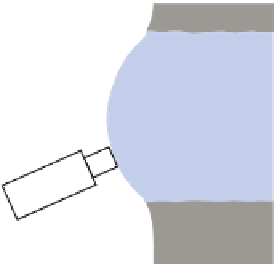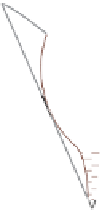Geoscience Reference
In-Depth Information
of the detector (Figure 11.2a). For a reading that characterizes a
particular bed it is best to place the detector perpendicular to
the bedding plane (Figure 11.2b). However, to obtain a reading
that is more comparable to a borehole record and which
averages the stratigraphic variation, it is better to place the
instrument perpendicular to the bedding (Figure 11.2c). Figure
11.2d shows the proportion of signal lost by placing the
detector on an uneven surface. This would result in a very
inaccurate measurement.
11
11.1.1 Instrument calibration and base stations
detector
Instruments need to be checked and calibrated regularly before
going out into the fi eld. A further good practice is to set up a
base station at a convenient location where a few readings can
be taken each day on the same spot to check for, and to
monitor, instrument drift. Not all 'drift' is an artefact of the
instrument, for example the strength of the Earth's magnetic
fi eld fl uctuates continuously (mainly diurnally but there are
shorter-term changes too), and apparent gravity at any point
varies because of tidal effects. These gravity variations can be
calculated, but magnetic changes have to be measured. In
practice there is no need to untangle either of these from the
instrumental drift; repeat readings at the base station show the
sum of both effects, which is all you need to know in order to
derive a correction for the time of your survey. These base-
station readings are also likely to reveal any problems with the
instrument.
(a)
(b)
11.1.2 Survey grids
A crucial part of any geophysical survey is setting up an
appropriate grid over which to take the measurements. The grid
needs to consider the resolution of the instrument, the size and
shape of the geological feature under investigation and/or the
overall objective, type of terrain and time available. The
resolution of the instrument is very important. It is not worth
surveying every 10 cm if the resolution of the instrument is
only 1 m. Likewise if the resolution of the instrument is only a
few centimetres then the survey needs to be designed so that
crucial data are not lost between measurement stations, unless
of course the purpose is a regional study.
detector
(c)
Figure 11.2
(a) Three-dimensional representation of the bell-shaped
volume (shown in red) over which the gamma-ray spectrometer measures.
Two-dimensional representation of the area that the instrument will detect if
used (b) parallel to the bedding plane, (c) perpendicular to bedding or (d)
at an angle.
(d)













































































































































































































































































































































































































































































































